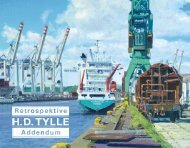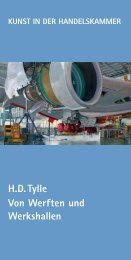- Seite 5:
Inhalt Contents Grußworte | Messag
- Seite 8 und 9:
Endpunkt wird die Deutschlandreise
- Seite 11 und 12:
Grußwort BASF Schwarzheide GmbH Me
- Seite 13:
For us, supporting promising artist
- Seite 16 und 17:
wo aus die riesigen Einzelteile nac
- Seite 18:
Peter Gercke I. 2009 - 2011 Deutsch
- Seite 21 und 22:
About four years ago, with his own
- Seite 23 und 24:
the fall of the Berlin Wall [and of
- Seite 25 und 26:
straight down to work at the variou
- Seite 27 und 28:
His experience of participation in
- Seite 29 und 30:
people in his triptych measuring 91
- Seite 31 und 32:
due to economic adjustments and eco
- Seite 33:
people working in factories who are
- Seite 36 und 37:
34 Pützer-Turm und Merck-Pyramide
- Seite 38 und 39:
36 Produktionsreaktor Zellkultur |
- Seite 40 und 41:
38 Pilotanlage | 2009 | 110 x 120 c
- Seite 42 und 43:
40 Reaktor für Flüssigkristallpro
- Seite 44 und 45:
42 Wasserturm | 2010 | 90 x 65 cm |
- Seite 46 und 47:
44 Alte und neue organische Produkt
- Seite 49 und 50:
BMW | München „Zukunft braucht H
- Seite 51:
BMW 3er Montage Werk München | 200
- Seite 54 und 55:
and cement-based external plaster,
- Seite 56 und 57:
54 Vorstudie | 19. August 2009, vor
- Seite 58 und 59:
56 Anhydritbergbau | 2009 | 110 x 1
- Seite 61 und 62:
Badische Stahlwerke | Kehl Die Badi
- Seite 63 und 64:
Stossofen Drahtwalzwerk | 2010 | 11
- Seite 65 und 66:
Elektroofen nach dem Chargieren | 2
- Seite 67:
Knüppelhalle | 2010 | 110 x 120 cm
- Seite 70 und 71:
wide automotive supplier for drivel
- Seite 72 und 73:
70 Halle 9, Band 2, Ecosplit-Montag
- Seite 75 und 76:
BASF | Schwarzheide Der Produktions
- Seite 77:
Kraftwerk | 2010 | 85 x 190 cm | Po
- Seite 80 und 81:
78 Am Kupolofen | 2011 | 85 x 140 c
- Seite 83 und 84:
Vattenfall | Cottbus Vattenfall ist
- Seite 85:
Tagebau Welzow-Süd | 2011 | 100 x
- Seite 88 und 89:
With 2,500 of its own employees and
- Seite 90 und 91:
88 Laserzentrum | 2011 | 100 x 140
- Seite 93 und 94:
Airbus | Hamburg Airbus ist mit sei
- Seite 95:
Aufgebockte A380 | 2011 | 100 x 180
- Seite 98 und 99:
96 Beladen der CSV Pyrenées | 2011
- Seite 100:
Peter Gercke I. 2009 - 2011 Deutsch
- Seite 103 und 104:
His plentiful studies in natural, c
- Seite 105 und 106:
In 2001, Grohmann donated this coll
- Seite 107 und 108:
Tylle’s familiarity with this col
- Seite 109 und 110:
Abschlagen der Oxydschicht | 2003 |
- Seite 111 und 112:
Ofenhalle (Aluminum Melting Furnace
- Seite 113 und 114:
Gießhalle | 2002 | 120 x 180 cm |
- Seite 115 und 116:
Kokillenmaschinen | 2002 | 90 x 150
- Seite 117 und 118:
Kernmacherei | 2003 | 90 x 120 cm |
- Seite 119 und 120:
Gießstraße | 06. Januar 2003 | 60
- Seite 121 und 122:
Endkontrolle | 2002 | 90 x 120 cm |
- Seite 123 und 124:
Quenching | 2002 | 80 x 60 cm | Que
- Seite 125 und 126:
Volvo Abgaskrümmer Produktion | 20
- Seite 127 und 128:
Oberflächenveredelung | 24. Oktobe
- Seite 129 und 130:
Gießereihalle | 28. Oktober 2003,
- Seite 131 und 132: Handwaschbeckenguss | 30. Oktober 2
- Seite 133 und 134: Produktionshalle | 2004 | 80 x 120
- Seite 135 und 136: Elementare Automatisierungstechnik
- Seite 137 und 138: Anschliffabteilung | 2004 | 100 x 1
- Seite 139 und 140: Messerproduktion | 2004 | 100 x 150
- Seite 141 und 142: Montage-Abteilung | 2004 | 100 x 15
- Seite 143 und 144: Verpackerin | 2004 | 100 x 75 cm |
- Seite 145 und 146: Vorheizen des Gusstiegels | 2003 |
- Seite 147 und 148: Abstich | 2003 | 90 x 130 cm | Cast
- Seite 149 und 150: Strangguss | 2003 | 90 x 130 cm | R
- Seite 151 und 152: EAF-Halle | 2007 | 140 x 110 cm | E
- Seite 153 und 154: Vor dem Verschließen des Ofens | 2
- Seite 155 und 156: Füllen der Zwischenpfanne | 2007 |
- Seite 157 und 158: Knüppelschere | 2007 | 80 x 120 cm
- Seite 159 und 160: Grobwalzwerk | 2007 | 80 x 120 cm |
- Seite 161 und 162: Verladen der Drahtspulen | 2007 | 8
- Seite 163 und 164: Rohrverlegung | 2005 | 95 x 73 cm |
- Seite 165 und 166: Schweißen der Pipeline | 2006 | 75
- Seite 167 und 168: Einebnen und Schottern | 2008 | 90
- Seite 169 und 170: Anschließen des Umspannwerks | 200
- Seite 171 und 172: Spiegelungen | 2006 | 110 x 120 cm
- Seite 173 und 174: 171
- Seite 175 und 176: Tylle’s artistic development as a
- Seite 177 und 178: conviction that painting even today
- Seite 179 und 180: Since 1979, it can be observed that
- Seite 181: Wolfsburg Final Assembly” also se
- Seite 185 und 186: Tylle works on location in the real
- Seite 187 und 188: process on an assembly line of a me
- Seite 189 und 190: and yet something quite extraordina
- Seite 191 und 192: Scarcely had each of us spotted a s
- Seite 193 und 194: ings the swift painting process to
- Seite 195 und 196: Der Formermeister, Eisenwerk Hensel
- Seite 197 und 198: Gießerei, Eisenwerk Hensel | 1979
- Seite 199 und 200: Preßwerkhalle, VW | 1980 | 135 x 1
- Seite 201 und 202: Karosserieschweißer, VW | 5. Septe
- Seite 203 und 204: Golf 1 - Montage, VW | 1980 | 155 x
- Seite 205 und 206: Die entlassene Prospekteinlegerin,
- Seite 207 und 208: Nachtschicht, KS | 1981 | 140 x 170
- Seite 209 und 210: Lokservice, Adtranz | 15. Februar 1
- Seite 211 und 212: Bofferding-Triptychon | 2004 | je 1
- Seite 213 und 214: Papierstreichmaschine, Nordland | 1
- Seite 215 und 216: Kupferelektrolyse (Mittelteil), Nor
- Seite 217 und 218: Bohrinsel in der Nordsee, Deilmann
- Seite 219 und 220: Schichtwechsel, Auguste Vicoria | 1
- Seite 221 und 222: Warten auf den Personenzug, Auguste
- Seite 223 und 224: Butterpause, Auguste Victoria | 198
- Seite 225 und 226: Abbau mit der Walze, Auguste Victor
- Seite 227 und 228: Der Hobelbegleiter, Auguste Victori
- Seite 229 und 230: Kippstelle NW, Kali und Salz | 1981
- Seite 231 und 232: Kernringschrämmaschine, Grasleben
- Seite 233 und 234:
Salzabbau bei senkr. Lagerung | 198
- Seite 235 und 236:
Auf der Strosse, Kali und Salz | 19
- Seite 237 und 238:
Ankerbohrwagen, Kali und Salz | 199
- Seite 239 und 240:
In der Werkstatt, Sachtleben | 20.F
- Seite 241 und 242:
Der letzte Gang, Sachtleben | 1991
- Seite 243 und 244:
Kontrolle der Kipprinne, Peine Salz
- Seite 245 und 246:
Hochofenabstich | 1985 | 140 x 220
- Seite 247 und 248:
Abstich am Hochofen A, Salzgitter A
- Seite 249 und 250:
Gießhalle, Georgsmarienhütte | 19
- Seite 251 und 252:
Stahlwerk, Peine Salzgitter | 1989
- Seite 253 und 254:
Breitbandstraße, Peine Salzgitter
- Seite 255 und 256:
Stahlwerk, Peine Salzgitter AG | 20
- Seite 257 und 258:
Im Stahlwerk, Peine Salzgitter AG |
- Seite 259 und 260:
Harmstorf-Werft | 1986 | 200 x 160
- Seite 261 und 262:
Tidar, Meyer-Werft | 1988 | 170 x 1
- Seite 263 und 264:
Dorolonda, Meyer-Werft | 2001 | 200
- Seite 265 und 266:
Super Star Leo, Meyer-Werft | 1998
- Seite 267 und 268:
HDW-Werft | 15. April 1999, vor Ort
- Seite 269 und 270:
HDW-Großdock 8a, Container-Fregatt
- Seite 271 und 272:
Galaxy, Meyer-Werft | 1996 | 180 x
- Seite 273 und 274:
Norwegian Dawn, Meyer-Werft | 2002
- Seite 275 und 276:
Trockendock Lloyd | 29. August 2002
- Seite 277 und 278:
Marmorabbau in Carrara, Omya | 1992
- Seite 279 und 280:
Hustadmarmor | 1993 | 120 x 210 cm
- Seite 281 und 282:
Marmorabbau bei Villach, Omya | 199
- Seite 283 und 284:
Kiesgrube, Bauer AG | 2001 | 140 x
- Seite 285 und 286:
Stahlwerke Salzgitter | 2002 | 100
- Seite 287 und 288:
Drei Arbeiter, Mansfeld-Kombinat |
- Seite 289 und 290:
August-Bebel-Hütte, Mansfeld Kombi
- Seite 291 und 292:
Die Freiheit, Mansfeld Kombinat | 1
- Seite 293 und 294:
Gegenlichtstudie, Mansfeld-Kombinat
- Seite 295 und 296:
Das Eisenwalzwerk von H.D. Tylle, n
- Seite 297 und 298:
1. Industrial art in the past H.D.
- Seite 299 und 300:
So whenever labor is depicted, the
- Seite 301 und 302:
clearly reflected in the structures
- Seite 303 und 304:
es. Workers are shown at the produc
- Seite 305 und 306:
time, his paintings were highly rea
- Seite 307 und 308:
tinued their previous artistic prod
- Seite 309 und 310:
Brochures into Newspapers” (1981)
- Seite 311 und 312:
Three points are relevant in this c
- Seite 313 und 314:
iences that would otherwise be inac
- Seite 315 und 316:
to their subjects more freely than
- Seite 317 und 318:
industries have recently become wea
- Seite 319 und 320:
Shift”) are about working conditi
- Seite 321 und 322:
man 1802, Bonhomme 1855 and Meunier
- Seite 323 und 324:
H.D. Tylle | About the Artist 1954
- Seite 325 und 326:
Stahlwerke Peine-Salzgitter, D Meye
- Seite 327 und 328:
Ausstellungen Exhibitions (E) Einze
- Seite 329 und 330:
1989 Salzgitter AG, Salzgitter (E)
- Seite 331 und 332:
Kunstsammlungen Kassel, 1991 „Ol
- Seite 333 und 334:
331
- Seite 335 und 336:
Prof. Dr. Klaus Türk, geb. 1944, D
- Seite 337:
We are extremely grateful to the mu




